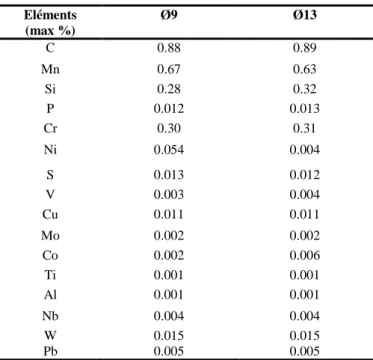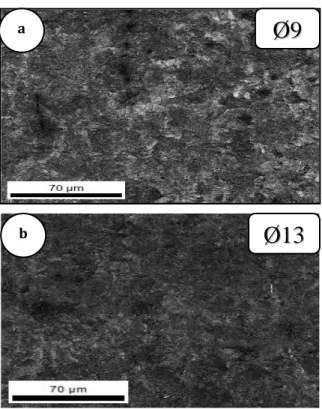ISMRE2018/XXXX-2018 ALGERIA
The Relationship between microstructure and
mechanical properties of strand Steel wires
Ahmed. Kisrane-Bouzidi†, Mosbah. Zidani†, Salim. Messaoudi† and Tahar. Abid* † Université Mohamed Khider Biskra, Laboratoire de Génie Énergétique et Matériaux ,
Faculté des Sciences et de la Technologie, Biskra 07000 Algérie. *Société de tréfilage et de fabrication de produits de soudage (Tréfisoud),
El-Eulma, Algérie. ahmedd.kisrane@gmail.com
Abstract— In this research, the relationship between microstructure and mechanical properties of Steel strands containing a nearly fully pearlitic structure is investigated. strands Steel used for different engineering and industrial applications such as : hoisting loads, aerial cable-ways, the bridges decks, suspension cables, the retaining walls, the petroleum platforms, airports etc. because they offer a right combination of strength and ductility. They are composed of drawn steel wire twisted helicaly around an axial wire. These wires are obtained by the wiredrawing process of a hard perlitic steel wire of carbon concentration close to the eutectoid composition followed by a thermo-mechanical treatment of stabilization. The main goal of this work is to undertake a preliminary characteristic study of high-carbon steel wire rods intended for manufacture of strands. The two wires which are in a rough state of hot rolling are investigated by the following experimental techniques : Microstructure, Vickers microhardness, Tensile test and X-ray diffraction analysis.
Keywords— Strand, High-carbon steel, Wire rod, Microhardness , X-Ray diffraction
I. INTRODUCTION
The starting material used for manufacture of the prestressed strands is called wire rod. The wire rod is a hot rolled long product having undergone a controlled cooling. In order to increase their mechanical strength, strands steels are hammer-hardened by wiredrawing [1]. This technique is a cold manufacturing process which consists of the wire rod passing under continuous traction, through a wire drawing die [2]. Steels usually used have a carbon concentration close to 0,9% and they are low-alloy steels. The iron-carbon diagram allows to notice that this type of strands steels is close to the eutectoid and thus made up mainly of pearlite [3,4].
This work is undertaken within the framework of intention for collaboration with the national company of wiredrawing and manufacture of welding products (Tréfisoud, Algeria), bearing on a preliminary study of characterization of the two hard steel wires rods used for manufacturing of strands in order to bring a better contribution to the choice of these steel grade of wires and also to ensure the good control of the properties during wiredrawing and stabilization.
II. EXPERIMENTS
The current study is a continuation and an extension of our previous works in [5]. Experiments were performed on two steel wires of diameters 9.00 and 13.00 mm containing approximately 0.88 wt. % of carbon intended for manufacture of strands. These wires have been provided by the national company of wiredrawing and manufacture of welding products (Tréfisoud, Algeria). The chemical composition of each wire is giving in table 1. In order to evaluate the wire mechanical properties, microhardness Vickers measurements (Load 200 g) was performed. A ZWICK microhardness meter was used.
TABLE I. CHEMICAL COMPOSITION OF USED WIRES
III. ERESULTS AND DISCUSSION A. Microstructure Observation
The results of analysis by optical microscopy show practically similar microstructures. Nevertheless, it is necessary to note a light difference in the repair of the grains which is obviously due to the composition and the speed of cooling during hot rolling. The two microstructures compose of the majority pearlite surrounded by ferrite [5] (Figure 1). Eléments (max %) Ø9 Ø13 C 0.88 0.89 Mn 0.67 0.63 Si 0.28 0.32 P 0.012 0.013 Cr 0.30 0.31 Ni 0.054 0.004 S 0.013 0.012 V 0.003 0.004 Cu 0.011 0.011 Mo 0.002 0.002 Co 0.002 0.006 Ti 0.001 0.001 Al 0.001 0.001 Nb 0.004 0.004 W 0.015 0.015 Pb 0.005 0.005
B. Microhardness measurements of steel wires
The results of the tests of Vickers microhardness on the longitudinal sections of the two wires show that the microhardness is about 391.6Hv/0.2Kg for the wire of diameter 09.00 mm and 382 Hv/0.2Kg for the wire of diameter 13.00. Kisrane-Bouzidi et al. (5,6) have noted that this small difference in microhardness is strongly related to the manufacturing process of the wire rods and can be also justified by the distribution and the smoothness of grains.
C. X-Ray diffraction analysis of steel wires
Fig. 1 presents the X-rays diffraction spectra of state rough wires of diameter 9.00 and 13.00mm. The spectra chows a slight variation (almost similar) of the intensities peaks of wires, this variation due probably to the distribution of the grains and the cooling speed during the hot rolling process. [5]
D. Mechanical characteristic (tensile test)
From the tensile tests curve shown in Fig. 2, the mechanical characteristics of two steel wire (9 and 13 mm) such as, the Young modulus, the limit elastic as well as maximum tensile strength can be determined.
According to these tensile tests, we can notice on the one hand, great tensile strengths of the two wire rods. They are respectively of approximately of 1220 and 1160 Mpa for two diameters 9.00 and 13.00 mm .in the other hand, the good aptitude for the plastic deformation revealed by a great elongation at fracture and a great constriction of two wires.
IV. CONCLUSION
The paper reports the results of the characterization of the two wire rods used for the manufacture of the strands, we can draw the following conclusions:
1. The two wire rods have appreciably similar microstructures which are microstructures mainly perlitic fines.
2. The values of the microhardness for the two wires are comparable with a distinction due to hot rolling.
3. The spectra of the X-ray diffraction are similar with a small variation of the intensity probably because of the cooling speed during hot rolling process.
4. The mechanical properties, tensile strengths, etc show that these wire are wire with high strengths and meet the requirements of the current international standards for wires used for prestressed strands.
V. CONCLUSION
[1] M. Perrin, ‘‘Étude et caractérisation par émission acoustique et mesures électro chimique es de la fragilisation par l’hydrogène des câbles de précontrainte’’, Application aux ouvrages d’art, Doctorate Thesis, INSA Lyon, 2009.
[2] M. Meknassi, N. Mouhib, M. Barakat, A.Hachim, M.El Ghorba, ‘‘Etude de comportement des fils du câble métallique soumis à la corrosion par d’acide sulfurique, 22ème Congrès Français de Mécanique, Lyon, France, 2015.
[3] A. Zelin, ‘‘Microstructure evolution in pearlitic steels during wire drawing’’, Acta Mater, Vol 50, 2002.
[4] G. Simonnet, ‘‘Tréfilage de l''acier’’, Techniques de l’Ingénieur, M645, pp 1–11, 1982.
[5] A. Kisrane-Bouzidi, M. Zidani, T. Djimaoui, M.C. Nebbar, T. Abid, L. Mebarki, ‘‘Caractérisation et Contribution au choix des Fils En Acier Dur Pour la Fabrication des Torons Précontraints’’, International congress on advanced technologies ICAT, Safi, Morocco,2017.
Fig. 2. X-ray diffraction spectra of the used wires
Ø
Ø
9
9
Ø
Ø
1
1
3
3
a bFig. 1. Microstructure of wires by MO: a)
Ø9, b) Ø13

